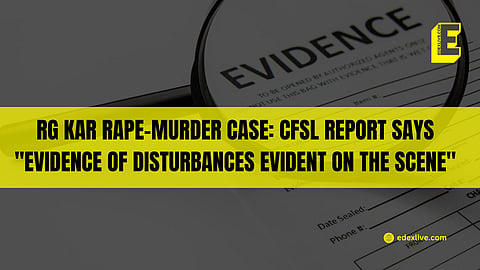

The crime scene in the RG Kar case “was not in well-preserved condition; there was evidence of disturbances evident on the scene,” a report from the Central Forensic Science Laboratory (CFSL), Delhi, has stated. This was stated in an exclusive report by The Indian Express.
The report, now part of the Central Bureau of Investigation (CBI) chargesheet, pertains to the rape and murder of a junior doctor at the hospital. Dated September 11, the 12-page document highlights key findings about the state of the crime scene.
The report was compiled by a 14-member multi-institutional medical board (MIMB) consisting of senior doctors, scientists, and forensic experts. The team visited the crime scene multiple times following the August 9 rape and murder, which occurred in the seminar room of the West Bengal government-run RG Kar Medical College and Hospital in Kolkata. The incident triggered widespread protests among doctors across West Bengal.
Sanjoy Roy, a civic volunteer with Kolkata Police, was arrested on August 10 in connection with the case.
Notably, former RG Kar director Dr Sandeep Ghosh has been accused of ordering renovations at the hospital shortly after the crime was reported. Allegations of “evidence tampering” and a “cover-up” surfaced after a memo, purportedly issued on the West Bengal government’s letterhead, instructed the Public Works Department to undertake urgent repairs at the hospital the day after the incident. This was stated in the exclusive report by The Indian Express.
On December 13, Dr Ghosh was granted bail by a local court in the evidence tampering case, as the CBI failed to file its chargesheet against him within the mandated 90 days. However, he remains in judicial remand in a separate case involving alleged financial irregularities at RG Kar.
The CFSL report claimed the team “forensically meditated on the given inputs vis-à-vis actual SOC (scene of crime) condition.”
“Here one demolished wall was evidently corresponding pre-presence of a door area, another demolished wall area was having fixed and functional electric peripherals and as such did not correspond to pre-presence of a particular passage. The concrete materials, building materials, broken tiles were found scattered on the floor of the said rooms and corridor also evaluated forensically by the CFSL team. The adjacent room (meant for in-house doctors’ rest purposes) was also found to be demolished in unprofessional manner. Its wall was found smashed that was corresponding to an entry gate,” the report said.
“In this restroom, some patient beds and wooden furniture with dirty mattresses/bedsheets were kept haphazardly, whereas, demolished concrete material was not found. The two wooden gate frames (stated to be removed) were found to be kept in front of the demolished wall of Room 1 (seminar room) in the corridor area,” it added.
The report also noted missing evidence of a possible struggle between the victim and the assailant. “Evidence of possible struggle ‘shown by the victim to the assailant or fight in between them found missing in the shown area of occurrence,’” it stated. “There is less possibility that someone (in the presence of the official attendees present in the 24×7 operational hospital corridor, doctor’s duty-nursing station area) can enter into the seminar hall unnoticed, for committing offence,” it added.
The report's findings have come to light as the victim’s parents moved the Calcutta High Court, requesting a fresh investigation into the case. They expressed their lack of faith in the ongoing probe by the CBI, which took over the investigation from Kolkata Police in August on the orders of the Calcutta High Court.
The parents' decision to approach the high court follows Dr Ghosh’s recent bail in the evidence tampering case.
